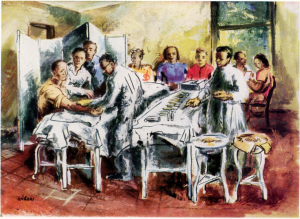National History Day Topic Update

Patients lining up for treatment for Hansen’s Disease in 1941
Everyone affiliated with National History Day learns something new about history every year. Students from various parts of the country dig up local history for their projects and could wind up presenting it to a national audience at the University of Maryland during the National Contest. While serving as a judge at the National Contest, I’ve learned about Amish struggles with public education officials, debates over fishing rights in the Northwest, and issues over American control of Guam. Students from Louisiana have the opportunity to take Louisiana’s unique history and bring it to this national audience as well. Last year, one of our top entries as a documentary on jazz diplomacy and some New Orleans musicians who traveled the world to soften harsh stances toward our country with music.
A topic that I have been learning about this year thanks to Elizabeth Schexnyder, Curator for the National Hansen’s Disease Museum in Carville, LA is reforms in the treatment of Hansen’s disease, formerly known as leprosy. The Museum is on the grounds of the last treatment center for Hansen’s disease, sometimes called the last “leper colony.” Carville is about 85 miles upriver from New Orleans, and the first patients were taken to the center by coal barge from New Orleans. In the 1890’s, residents of New Orleans were terrified to learn that a treatment center for the disease could be located in their city, so a more isolated location was selected. Even in the isolated setting, the lease of a plantation in Carville was done under the pretense that it was going to be an ostrich farm.
To my knowledge, Carville’s treatment center has never been used as a National History Day topic. Carville’s unique history is tailor-made for the 2012 theme, Revolution, Reaction, Reform in History. It also has many primary sources available. The STAR newsletters of the National Hansen’s Disease Treatment Center are available through the Louisiana Digital Libraries. In 2009, two Carville based memoirs were released. One written by a former patient of Carville ‘Squint: My Journey with Leprosy’ by Jose Ramirez, Jr. is an account written by a sufferer of Hansen’s disease, and ‘In the Sanctuary of Outcasts: A Memoir’ by Neil White sheds light on the brief time that Carville also housed a federal prison. In addition, The Times-Picayune of New Orleans has many articles detailing leprosy in the 1890s and the efforts to house a treatment center near Tulane University.
Today, the National Hansen’s Disease Museum lets the visitor experience the story of Carville, the National Leprosarium built for long-term quarantine of leprosy patients. Patients, many quarantined for life, left behind photographs, memorabilia, and their stories. Exhibits, resources and topics of investigation include:
Public Health Service; Hansen’s disease and the Law; The history of Quarantine, Daughters of Charity and Public Health Nursing; Patient Advocacy; The STAR Magazine (patient published), Medical Adaptations; Laboratory Research; “Leprosy in the News” Collection, Staff and Patients’ Oral Histories, Rehabilitation and Treatment of Hansen’s disease; Site History and Photography.
This post by Louisiana History Day Coordinator Nathan Huegen and Elizabeth Schexnyder, curator of the National Hansen’s Disease Museum
- Posted :
- Post Category :
- Tags :
- Follow responses to this entry through the RSS 2.0 feed. You can skip to the end and leave a response. Pinging is currently not allowed.




Leave a Reply